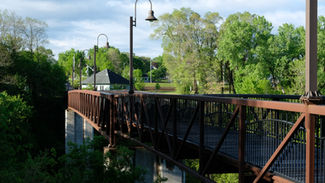Thinking Geographically
A geographic perspective means recognizing and observing the geography of things. Geography is people, place, space, scale, pattern, proximity, movement, landscape, and the relationships between them. It is the interaction between nature and society. It is found in natural, rural, and built environments. As presented below, geography is central to community. Community is inconceivable without geography.
Scale
Scale, at both the perceptual and the physical levels, is a critical characteristic of community. Communities are experiences at the macro, micro, or individual scales of engagement. At the macro scale, community involves common goals and purposes. At the micro scale, relationships rely on cooperation and responsibility. The individual scale is about identity and emotional connection to the community. The physical scale – the size of the community – also influences individual opportunities and experiences, including jobs, education, healthcare, entertainment, mobility, and access. Individuals become less engaged and committed to community as the scale of a community increases.
Mobilities
Mobility includes transportation, accessibility to amenities and services, and the movement of individuals between places. Public transportation (congregated transportation) and biking/walking enable face-to-face interaction among people, foster familiarity, and help in forming social bonds and trust (see photo below). Equitable access to transportation creates an inclusive environment that reduces disparity and builds social capital. Infrastructure such as bike/walking paths, sidewalks, and bridges/tunnels, can be used to enhance mobility in a community; roads/highways can also serve as barriers and obstacles.
Public Services & Institutions
Public services and institutions reveal a community’s priorities and commitments and create a collaborative, foundational network for meeting community needs. They are systems in which community members feel served and cared for. From social services and food banks to libraries, schools, and community programming, public and not-for-profit service institutions are designed to meet the needs of all members and strengthen community. The lack of institutional support may sometimes strengthen community through collective and collaborative action in response to unmet needs.
Amenities and Nodes
Community is enhanced by public and private third spaces such as libraries, food banks, community centers, places of worship, taverns, community gardens, playgrounds, farmers markets, and coffee shops (see photos at right). Such social infrastructure provides a framework for bridging and bonding social capital through daily interaction of diverse people, promotes locally informed public policy and practice, and has the power to foster a sense of community, belonging, and security. Vibrant third spaces enhance community.
Political & Cultural Contexts
Cultural contexts and political systems can be broken into the historical and cultural practices that impact the role of government. Placed in relationship with our definition of community, these practices and roles shape the daily social interactions within public spaces. When there is strong communication between cultural communities and political systems, political systems can better produce public services, institutions, and mobility networks for community members. Participatory governments create welcoming environments that encourage all community members to innovate, provide educational opportunities, and cultivate continuous and sustainable communities.
Cultural Landscapes
Cultural landscapes include art, architecture, signs, and symbols. Community can influence cultural landscapes through the creation and dispersion of symbols such as public art that reflect the lives of individuals and encapsulate the experiences and identities within the community. Architectural structures impact a community by creating spaces that can prevent or provide opportunities for interaction. Art and architecture create landmarks for those in the community, increasing their sense of place. In Eau Claire, the rivers, Phoenix Park, and unique bridges serve as distinct and telling landmarks. The landscape can also be used to communicate inclusivity, e.g., blue lights for sexual assault awareness (see photo at left).
Sense of Place
Sense of place refers to an individual’s feelings toward their community and it provides a basis to better understand people-place relationships. Sense of place can directly influence people’s decisions regarding spaces that they feel an attachment towards. Sense of place develops in spaces with vibrancy, that are full of life and have distinctive features; sense of place is diminished in spaces lacking such qualities. A shared sense of place is also a building block for community as people share positive emotional connections and commitments to shared spaces and cooperate in efforts to improve and maintain community.♥
Demography
Demography in a community involves the structure and social interactions between individuals based on such characteristics as age, race, migratory characteristics, employment, education, population density, and home ownership. Uneven development, opportunity, and social justice can create disenfranchisement and a lack of sense of place and support that individuals seek in their communities (see above photo). Demographic diversity plays an important role in creating equitable, healthy, and abundant communities of intergenerational and intercultural connections, open communication, inclusion, security, and shared or mutually valued goals and beliefs.
Physical Environments
The relationship between community and the surrounding physical environments is intertwined with personal experiences, weather/climate and topography, and relationships between community members. Social cohesion and community engagement is connected to how we adapt to and benefit from the physical environment – society impacts environmental processes and vice versa. The community of Eau Claire integrates with the proximate agricultural resources and relies on the Chippewa & Eau Claire Rivers as a water and food source, for recreational activities, and its aesthetic beauty.
Socio-economics
The distribution and flow of wealth affect community functions and influence the quality of relationships and strength of a community. The socio-economics of a community centers on its economic strength and equity and is a function of the community’s diverse – and often locally owned – businesses, agriculture and tourism industries, resource management, housing tenure, development activities, and gentrification. Strong communities exist where people’s daily needs and welfare are met through widespread participation in a solid functioning of the local economy.









